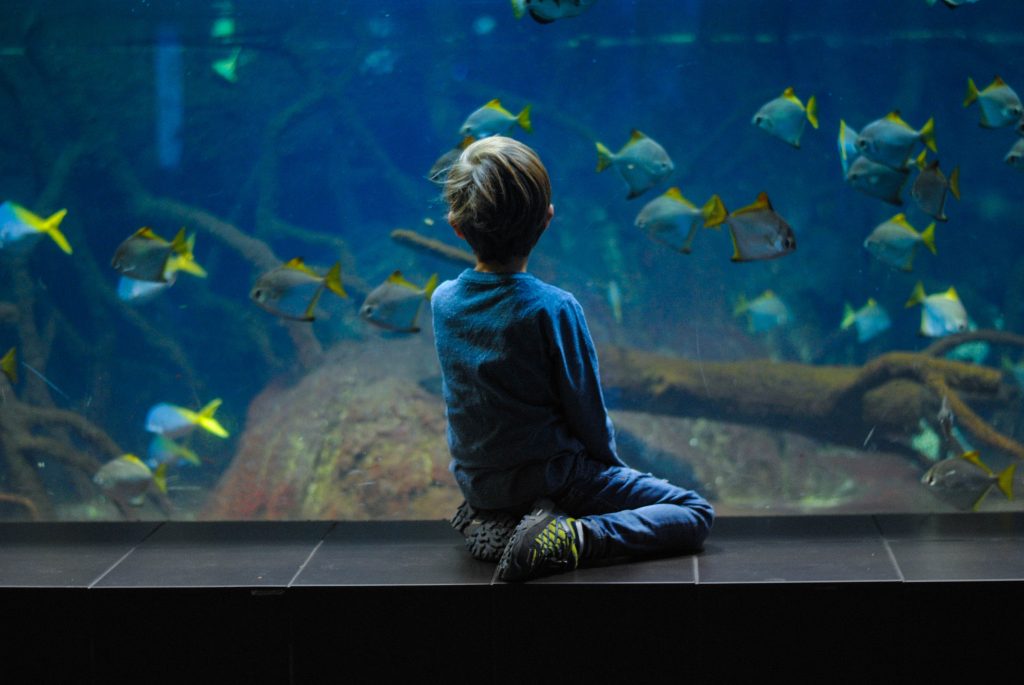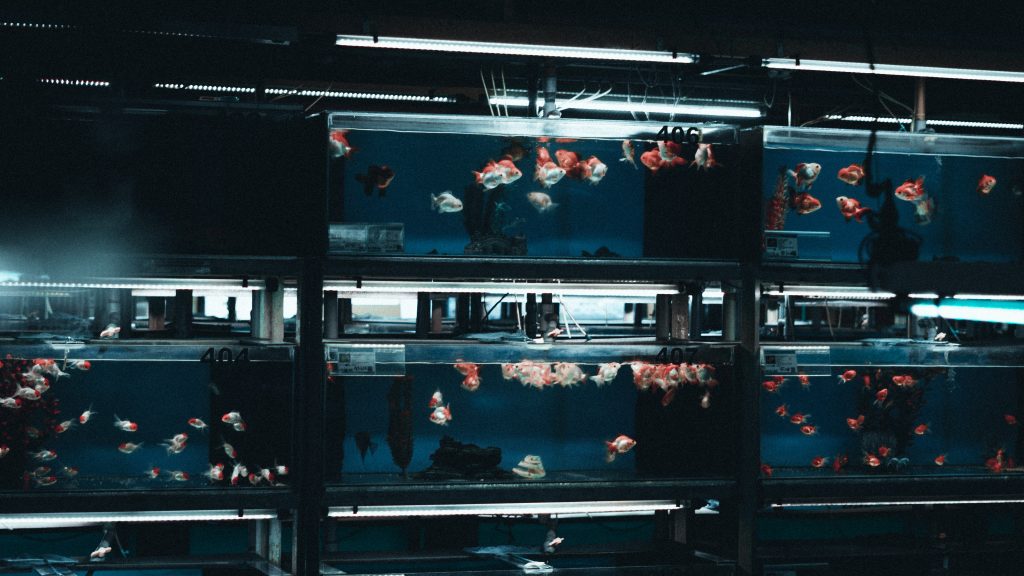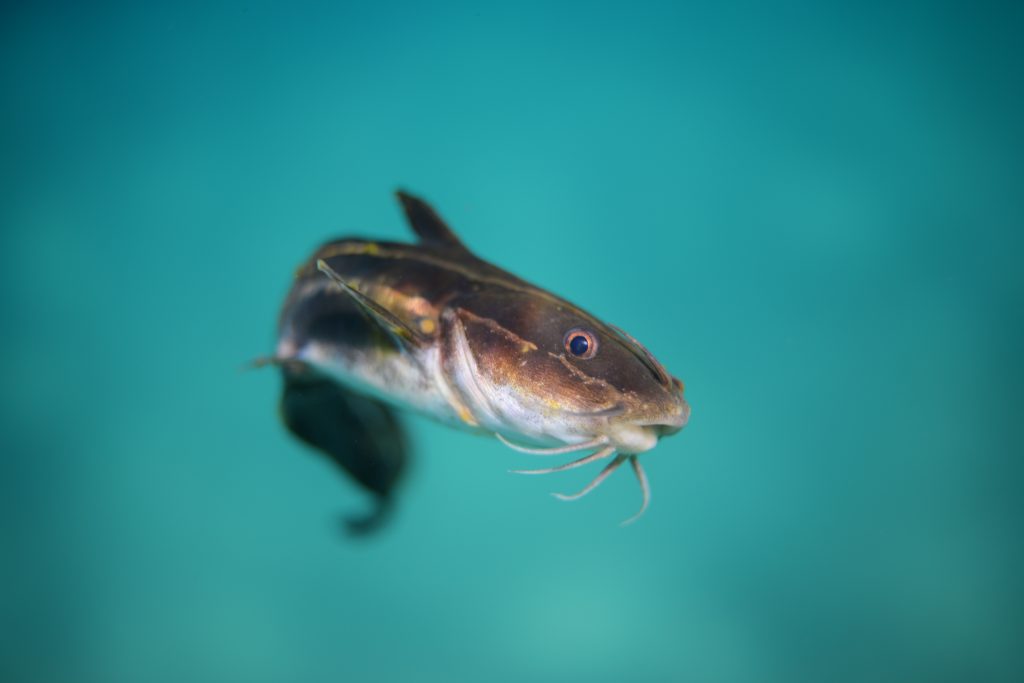by Roberta Gibson
What comes to mind when you think of a tropical fish tank? An aquarium in a restaurant? A doctor’s office? Or is it the memory of your own childhood tank filled with mollies and guppies?

My earliest recollections are of the local tropical fish store, a small independent business in the basement of a house. Our whole family would troop down the stairs into the air that was warm and humid, like stepping into the tropics regardless of season. Thousands of fish swam in gloriously lit tanks. My sister and I would each get to choose a fish. After long and careful deliberations, into the plastic baggie they would go. In the car, we would carefully hold our prizes upright in the bag all the way home. Then the fish would sit in a plastic-baggie bubble-like world floating in the top of the tank until the water temperature reached that of the surroundings, probably a half hour or so — seemingly forever to a small child. At last it was time for release. Our fish were home.
Keeping tropical fish is not only a popular hobby, it can be educational. I am astonished how much fish biology, chemistry, and physics I remember from our family’s fish tank. However, do not make the common mistake of thinking that fish are pets that require no care. Setting up and maintaining a tank correctly takes time, money, and energy. As an adult I find the mixing and correcting of water quality tedious and my husband has taken over that chore. But as a child it was a great opportunity to learn responsibility.
Where to start? Check out a book or two from your library or surf the Internet. You will need to know about things like filtration, aeration, water quality, and the type of tanks available that would best suit your needs. Also, you will need to decide whether you want saltwater or freshwater. Spend some time in pet shops and hobby shops to see what options are available.
Freshwater versus Saltwater
Generally, a beginner should start with a freshwater aquarium. The saltwater fish can be enticing to look at, but the water chemistry is much more complex. Also, a majority of tropical freshwater fish are raised here in the United States, mostly in Florida. Saltwater fish are difficult to raise and are often collected in the wild, sometimes in less than environmentally friendly ways.
Placement

Think carefully about where your tank will go. I would not recommend setting it up in a child’s bedroom; the aeration equipment can be noisy. Think of the tank as a major piece of furniture and plan accordingly. Also, it will need to be near an electrical outlet. If you have only a small counter space available, keep that in mind when the salesperson at the pet shop tries to sell you a thirty-gallon tank.
Equipment
What will you need? You will need a(n):
- Tank
- Filter
- Thermometer
- Heater
- Air pump
- Plastic tubing
- Cover (probably with a light)
- Aquarium gravel
- Assorted plants (live and/or plastic)
- Decorations
- Fish net,
- Water test kits
- Cleaning tools
- Bucket to hold waste water (optional)
- Timer for the light (optional)
All this may be purchased as a kit or separately. The price and quality will vary considerably. Try pet stores, department stores, and hobby shops before you buy. You can also shop on the Internet or mail order catalogs. The ideal situation for learning what you will need is a visit to the local hobbyist who runs a small business, but those are rare these days.
Water Quality
Next you will need some water for your fish. Guess what? Not just any water will do! Is your child ready for chemistry? You will need to find out the pH and hardness of your drinking water. Many pet stores will perform water quality analysis as a service, usually for free. But it is also fun to purchase a test kit and do some of the analysis yourself.
The pH is a measure of the hydrogen ions dissolved in water, or more simply, a measure of whether the water is acidic or basic. Tropical fish prefer a pH of nearly neutral, around the 6.8 to 7.4 range. Typically, alkaline waters, those with pH above 7.0 (which is neutral), have a lot of dissolved salts in them. That is the case with our water here in the Southwest. You may have to add water conditioners to correct your water hardness or choose fish that can tolerate more alkalinity such as mollies and tetras, or both. Never use pure distilled water or rainwater because it does not have enough salts, which is just as bad as being too salty. If your water is chlorinated, then you will need to let it set out for a while and add conditioners to remove the chlorine before use.
Your child may suggest using pond or lake water; after all, the lake fish live in it okay. The problem is that the lake fish may have diseases or parasites that can be transferred to your fish. Tap water is still better.
You want to keep the numbers of fish low, especially at first, because too many fish can also change water quality through the build-up of wastes. When fish waste and uneaten food decompose in the tank, they can cause a rise in the levels of ammonia. Ammonia is that strong-smelling chemical in some household cleaners. Can you imagine swimming in that? Bad news!
You can buy test kits for testing your ammonia level. If it is high, you will need to clean the tank, add special bacteria that help remove ammonia, and/or modify your filtration system. Also, make sure you are not feeding the fish more than they can clean up in a few minutes.
Try to clean the tank and refresh the water on a regular basis, such as every few weeks. Never use soap or detergent on any of the equipment that will come in contact with fish. Only change up to half the water at any one time, and add your specially conditioned water at room temperature or as close to the tank temperature as possible.

Temperature
After you set up your aquarium and fill it with water, then you will need to adjust the heater to the proper temperature before adding fish. Tropical fish tend to be quite sensitive to changes in water temperature. Check for the optimal temperatures for the fish you are going to chose and make sure your heater can hold those temperatures over at least twenty-four hours. Your children will be impatient for their fish, but getting the heater working will save a lot of heartache — and fried fish — in the long run.
Choosing the Right Fish
If you have done your biology homework, you will know that you need to purchase fish that get along with one another. Some fish are docile, others can be aggressive to other fish. It is usually best to buy a few of each kind because most fish like to school together in a tank. All the fish should be roughly the same size. A bottom feeding catfish or algae eater is usually recommended to help keep the tank cleaner. Show your children how the mouth is pointed down on the bottom feeder. You will also need to buy an appropriate fish food.

Fish Disposal – A Matter of Life and Death
Eventually you will have to deal with illness and death in a fish tank. It is a good idea to be prepared and use this as a teaching moment. Never flush a dead or dying fish down the toilet; that spreads the illness and is cruel to the fish. Freezing a fish is not a good idea either. A good way to dispose of a dead fish is to bury it in the backyard, if possible. Fight the urge to buy another similar fish at the store and hope your child doesn’t notice. Let your child know what is happening and discuss it instead.
Going Further
If your children become fascinated with fish, you can try some Fish Activities Without Water. Most can be done without a tank at home.
Careers
Let your children know that the science of raising fish, called aquaculture, is a promising field for the future. They can also study fisheries biology, marine biology, or oceanography. Research Marine Biologist Eugenie Clark. She started her career as a young girl with an aquarium at home. Who knows what career your fish tank might launch!

Roberta Gibson worked for a number of years as an entomologist before she caught the writing bug. Her debut picture book “How to Build an Insect” was released in April 2021. You can visit her at https://robertagibsonwrites.com/ , Growing with Science Blog, Twitter @RobertaGibson, or Instagram @RobieGibson.
